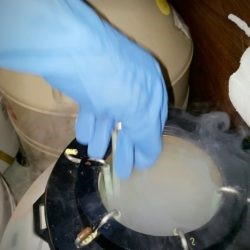Semen cryopreservation
is the oldest and the most successful option for fertility preservation in male, where the sperms are frozen before initiating treatments like chemotherapy, radiotherapy or infertility.
Another modality is the cryopreservation of testicular tissue, where the tissue from testis is frozen.
This tissue can later be thawed and sperm extracted for usage with eggs to create embryos.
Timely consultation and initiation of the procedure is the key to preserve the fertility of cancer patients.
Cryopreservation is a technique used to preserve intact egg, oocytes, sperm , tissue etc., by freezing them at a temperature of -196° C in liquid nitrogen.
At such a low temperature, any chemical or enzymatic activity that can damage the biological material is stopped so the material is preserved for a long period of time.
Freezing :
Different species of plants show different types of sensitivity to low temperatures. They are different types of methods:
-
Slow Freezing Method
In this process, the tissue or plant material is slowly frozen at a slow cooling rate.
The major advantage is that the plant cells are partially hydrated and serve in a better manner.
-
Rapid Freezing Method
The vials are plunged in liquid nitrogen. In this process, the temperature decreases from -300 to - 1000 degrees rapidly.
-
Dry Freezing Method
In this method hydrated cells and seeds are stored.
-
Storage in Liquid Nitrogen
It is also important for the maintenance of the sale or material at a specific temperature. In general, the temperature is kept - 70 to - 196°C.
Prolonged storage is done at the temperature of -196 °C in liquid nitrogen. A continuous supply of nitrogen is needed to prevent damage.
Sperm or semen cryopreservation is a method of sustaining the viability of sperm over a long period of time by cooling and storage in or above liquid nitrogen (about -196°C).
Cryopreservation of sperm allows the sperm to be used for attempts at insemination and fertilization, with the goal of causing a pregnancy.
PROCEDURES
- Semen will be collected by self-masturbation into an approved sterile container, at a site provided by the lab, except under special circumstances.
- The semen, or the sperm obtained from the semen will be processed according to established Laboratory protocols
- Different techniques of sperm cryopreservation may be used on subsequent samples to optimize the results. The semen or sperm will be cryopreserved and stored in or above liquid nitrogen. A semen analysis is performed on the fresh semen.
- Different techniques of sperm cryopreservation may be used on subsequent samples to optimize the results. The semen or sperm will be cryopreserved and stored in or above liquid nitrogen. A semen analysis is performed on the fresh semen.
- The cryopreserved sperm, must meet certain criteria for motility and viability before they are considered adequate for use in inseminations.
-
The estimated quality and quantity of sperm after thawing will determine the type of insemination technique (intra-uterine, in vitro fertilization, intracytoplasmic sperm injection) best suited for each sample. The control and disposition of the frozen semen or sperm belongs alone to the patient,
with exceptions listed on the Legal Statement for Control and Disposition of Cryopreserved Sperm or Semen.
- The patient will need to execute the legal statement regarding future control and disposition.
BENEFITS & RISKS
- The benefits of cryopreserving and subsequently thawing sperm or semen include:
- Extend the chances of causing a pregnancy from the present to a much later time;
- There is a risk of failure of fertilization and pregnancy with your frozen and thawed sperm.
-
Experience has shown that the pregnancy rate for couples using cryopreserved sperm may be slightly lower than that experienced with fresh sperm.
Studies do not show any increased risk of birth defects associated with the use of frozen-thawed sperm for insemination.
- Cryopreservation and thawing of sperm or semen generally adversely affects at least some of the measurable characteristics of sperm.
- Cryopreservation and thawing of sperm or semen generally adversely affects at least some of the measurable characteristics of sperm.
- The viability and motility of frozen-thawed sperm is usually lower than that of fresh sperm.
- For some men, or for some semen samples of any man, cryopreservation and thawing may adversely affect the sperm so that most or all of them may be non-moving or dead.
- There is no accurate method to determine ahead of time how well the sperm will survive the procedure, although semen samples with normal-to-excellent sperm characteristics generally can be cryopreserved and thawed successfully.
- Another risk of insemination of frozen-thawed sperm is the possible infection of the recipient woman with a bacterium, virus or other micro-organism that was present in the semen at the time of cryopreservation.
- This risk may be the same as the risk of infection from the same man’s fresh semen.
Thawing process
-
The thawing of sperm is an equally important step as freezing: the cell must be allowed to recover its normal biological activities while avoiding abrupt thermal changes. Generally, the cryopreservation protocols use a thawing temperature of 37 degrees Celsius.
Even if higher thawing temperatures allow for more rapid heating, they are not used because of the risks of cell damage.
-
Once the sperm cells are thawed, they are separated from the cryopreservation medium by being washed in culture medium and centrifuging.

